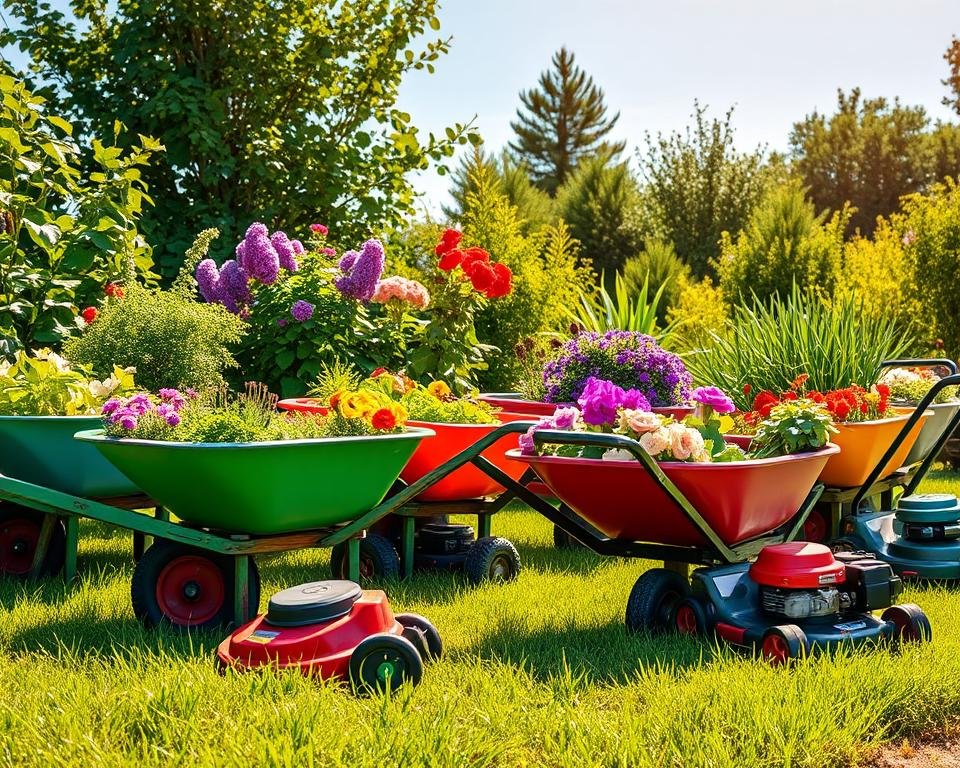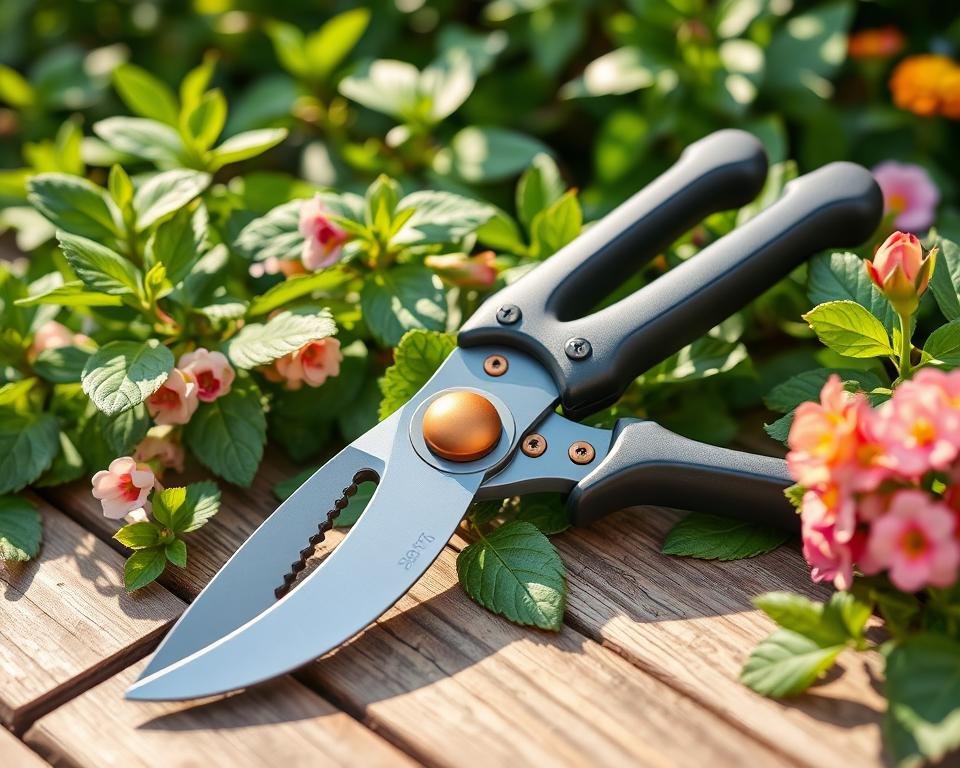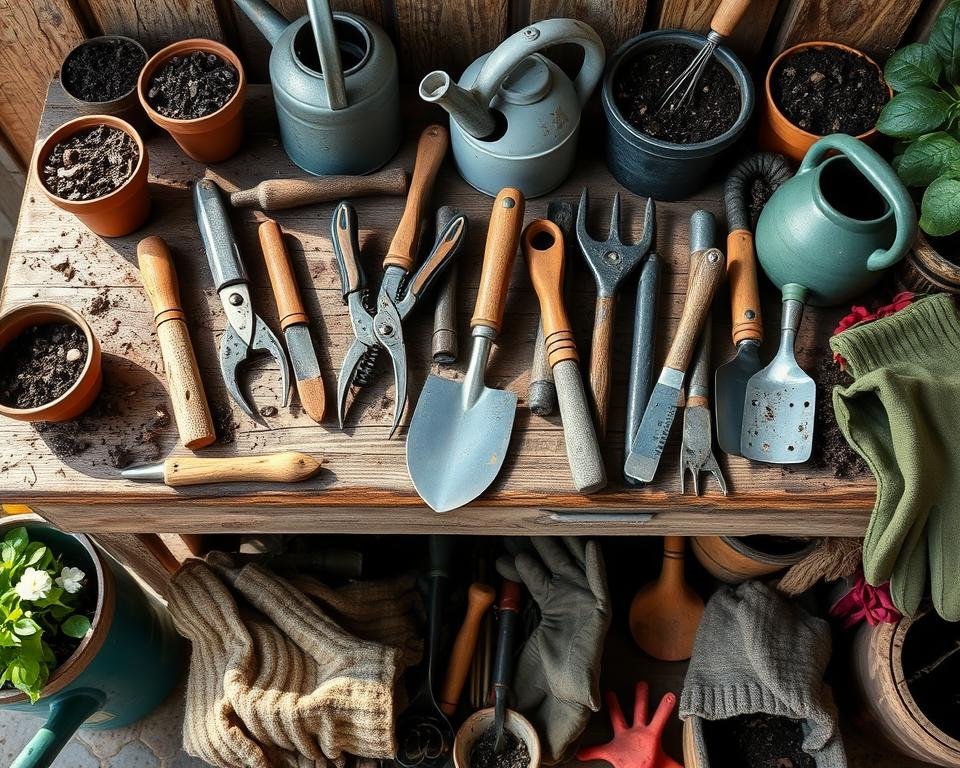As a passionate gardener, you know that well-maintained tools are crucial for a thriving garden. But have you ever wondered how to keep your pruning shears, shovels, and other essential gardening equipment in top shape? What’s the secret to ensuring your tools perform at their best year after year?
In this comprehensive guide, we’ll explore the art of sharpening and caring for various gardening tools. We’ll cover everything from pruning shears and loppers to shovels, rakes, hoes, and lawn mowers. You’ll learn how to extend the life and efficiency of your gardening arsenal. Get ready to unlock the full potential of your tools and transform your gardening experience!
Introduction to Gardening Tools
Gardening tools are key for anyone who loves gardening. They help you care for your plants, whether it’s flowers or veggies. Tools like shovels and rakes are essential for a great garden.
Importance of Proper Tool Maintenance
Keeping your gardening tools in good shape is vital. Sharp, clean tools last longer and work better. Regularly sharpening and cleaning your tools will help them last.
Overview of Common Gardening Tools
- Pruning shears: Essential for precise trimming and cutting of plants, shrubs, and trees.
- Shovels: Indispensable for digging, turning soil, and transplanting plants.
- Rakes: Invaluable for clearing debris, leveling soil, and aerating lawns.
- Hoes: Versatile tools for weeding, cultivating, and preparing garden beds.
Knowing how to maintain your tools and what tools you need is important. With the right tools and care, your garden will grow and flourish.
Sharpening Pruning Shears and Loppers
Keeping your gardening tools in good shape is key to their lasting performance. For pruning shears and loppers, sharpness is vital for clean cuts on plants and trees. Let’s look at how to sharpen these important tools.
Sharpening Pruning Shears
Pruning shears are essential for gardeners, but their blades can dull over time. To sharpen them, follow these steps:
- Use a sharpening stone or file made for pruning shears. Hold the blades at 20-25 degrees and file or stone the edges smoothly.
- Remove any filings or debris, then oil the pivot point with machine oil or silicone.
- Test the shears by cutting a branch or stem. If they’re still dull, sharpen them again until sharp.
Sharpening Loppers
Loppers are great for cutting thick branches. Sharpening them is just as crucial as pruning shears. Here’s how to sharpen your loppers:
- File the blades at a 20-25 degree angle with a flat mill file or lopper sharpener, starting from the inside.
- Wipe off filings and apply a thin layer of oil or silicone to the pivot point and moving parts.
- Test the loppers by cutting a thick branch. If they’re still dull, sharpen them again until sharp.
Regular sharpening of your pruning shears and loppers keeps them in great shape. It also makes gardening easier and more efficient. Proper tool maintenance leads to years of reliable use.
| Tool | Sharpening Angle | Sharpening Tool | Maintenance |
|---|---|---|---|
| Pruning Shears | 20-25 degrees | Sharpening stone or file | Lubricate pivot point with machine oil or silicone-based lubricant |
| Loppers | 20-25 degrees | Flat mill file or lopper sharpener | Lubricate pivot point with machine oil or silicone-based lubricant |
Maintaining Shovels and Rakes
Shovels and rakes are key tools for gardeners. But, they can wear out if not cared for. Cleaning, sharpening, and maintaining these tools is important. It helps them last longer and work better.
Cleaning Techniques for Shovels and Rakes
It’s important to keep shovels and rakes clean. This helps them last longer and work better. Here’s how to clean them:
- Use warm water and a mild detergent or soap in a bucket.
- Soak the tool for 10-15 minutes to loosen dirt.
- Scrub it with a stiff-bristled brush, focusing on edges and corners.
- Rinse it well with clean water to remove soap.
- Dry it with a cloth or let it air dry before storing.
Cleaning them regularly keeps them looking good and working well. It also stops rust and keeps edges sharp.
| Tool | Cleaning Frequency | Recommended Cleaning Method |
|---|---|---|
| Shovels | After each use | Wipe down with damp cloth, deep clean with warm water and mild detergent as needed |
| Rakes | After each use | Wipe down with damp cloth, deep clean with warm water and mild detergent as needed |
By following these easy tips, you can keep your shovels and rakes in great shape. This ensures they work well for many years.
Caring for Hoes and Cultivators
Keeping your gardening tools, like hoes and cultivators, in good shape is key. These tools help control weeds and aerate the soil. So, they need your care and attention.
Cleaning and sharpening hoes and cultivators can make them last longer and work better. First, clean the blades well to remove dirt and debris. Use a wire brush or steel wool for tough spots, then clean them with a cloth.
- Sharpen the blades with a file or sharpening stone for a sharp edge.
- Put a thin layer of oil on the metal parts to stop rust and corrosion.
- Keep your hoes and cultivators dry and safe when not using them.
By caring for your hoes and cultivators, they’ll keep working well. This helps you keep your garden healthy and weed-free for many years.

Remember, taking care of your gardening tools is crucial for gardening success. A bit of effort can keep your hoes and cultivators in great shape. This makes gardening easier and more efficient.
Gardening Tools: Watering Cans and Hoses
Watering cans and garden hoses are key for keeping plants healthy. But, they can rust and leak if not cared for. We’ll look at how to stop these problems and keep your tools working well.
Preventing Rust and Leaks
Rust is a big problem for these tools, especially in wet places. Clean and dry them after each use. Rinse the can and wipe it down with a cloth. For hoses, drain them fully before storing.
Use oil or spray to protect against rust. It keeps moisture away and stops rust from forming. Check your tools often for damage to catch problems early.
Leaks in hoses are common. They happen when the material wears out. Look for cracks and replace the hose if needed. For small leaks, use tape or sealant to fix them.
| Tool | Maintenance Tips | Rust Prevention |
|---|---|---|
| Watering Can |
|
|
| Garden Hose |
|
|
By taking care of your watering cans and hoses, they’ll last a long time. They’ll help your garden grow strong and healthy.
Wheelbarrows and Lawn Mowers: Maintenance Tips
Keeping your wheelbarrows and lawn mowers in good shape is key. They are big tools that need special care. Here, we’ll share tips on cleaning, lubricating, and caring for them.
Caring for Wheelbarrows
Wheelbarrows handle heavy loads and tough terrain. So, they need regular upkeep. Start by cleaning them well, removing dirt and debris. Use a wire brush on metal parts and then wipe with a damp cloth.
Next, check the wheel bearings and tighten any loose parts. Apply lubricant to the bearings and moving parts to reduce friction. Also, check the tire pressure often and replace tires if they’re worn out.
Maintaining Lawn Mowers
- Sharpen the lawn mower blades at the start of each season or after 20-25 hours of use.
- Clean the mower deck underside to prevent grass clippings and debris buildup.
- Change the oil as the manufacturer suggests to keep the engine running well.
- Replace the air filter if it’s dirty or clogged.
- Check and replace the spark plug if needed for smooth engine operation.
| Maintenance Task | Frequency |
|---|---|
| Sharpen Blades | Beginning of season or every 20-25 hours |
| Clean Mower Deck | After each use |
| Oil Change | As per manufacturer’s recommendation |
| Air Filter Replacement | As needed |
| Spark Plug Replacement | As needed |
By following these tips, your wheelbarrows and lawn mowers will stay in great shape. Always follow the manufacturer’s instructions and safety guidelines when maintaining them.

Gardening Tools: Proper Storage and Organization
Keeping your gardening tools in good shape and easy to find is key for a great gardening experience. A dedicated spot, like a tool shed or cabinet, helps keep tools safe and organized. This makes them quick to grab when you need them.
Creating a Tool Shed or Storage Area
A tool shed or cabinet is a great way to store your gardening tools. Here are some tips for setting up your tool storage area:
- Choose a spot that’s easy to get to from your garden or yard, but also keeps out the weather.
- Get a strong, weatherproof shed or cabinet to protect your tools from the elements.
- Use vertical space with shelves, hooks, or pegboards to keep your tools tidy.
- Label or color-code your tools so you can find them fast.
- Check your tool storage often and keep it up to prevent rust, wear, and damage.
| Tool Storage Solution | Advantages | Disadvantages |
|---|---|---|
| Tool Shed | Offers lots of storage, keeps tools dry, and can be customized | Takes up more space and might cost more to build or buy |
| Tool Cabinet | Compact, flexible, and works indoors or outdoors | Has less room than a shed |
Investing in a good tool storage solution and keeping your tools organized ensures they stay in great shape. This way, they’re always ready when you need them.
Conclusion
Keeping your gardening tools in good shape is key to their long life and effectiveness. This article has shown you how to sharpen, clean, and care for many tools. This includes pruning shears, loppers, shovels, rakes, hoes, and cultivators.
Proper storage and organization of your gardening tools also matter. They protect your tools from the weather and keep your garden area neat.
If you love gardening or are just starting, taking care of your tools is worth it. Sharp, well-maintained tools make gardening easier and safer. So, spend time sharpening, cleaning, and storing your tools. Enjoy a beautiful, healthy garden for many years.
By focusing on your gardening tools’ care and maintenance, you’ll make them last longer. You’ll also enjoy gardening more and get better results. Remember, well-kept tools are the heart of a successful gardening journey.
FAQ
What are the most important gardening tools to maintain?
Key gardening tools include pruning shears, shovels, rakes, hoes, watering cans, and garden hoses. Also, wheelbarrows and lawn mowers are crucial. Keeping these tools sharp and clean ensures they work well for years.
How often should I sharpen my pruning shears and loppers?
Sharpen your pruning shears and loppers at least once a year. If you use them often, do it more. Sharp blades prevent plant damage and make cuts clean.
What’s the best way to clean and maintain shovels and rakes?
Clean shovels and rakes after each use with a stiff-bristle brush and soapy water. Dry them well and apply oil to prevent rust. Sharpen their edges regularly for smooth cuts.
How can I prevent my garden hose from leaking and cracking?
Store your garden hose coiled and out of sunlight when not in use. Check it for wear and replace it if damaged. Using a hose protectant can also help.
What’s the best way to maintain my lawn mower?
Keep your lawn mower in good condition with regular maintenance. Clean the undercarriage, sharpen the blades, and change the oil. Also, check the air filter and spark plug. Follow your mower’s manual for maintenance schedules.
How should I store my gardening tools over the winter?
Clean and dry your gardening tools before winter storage. Apply oil to metal parts to prevent rust. Store them in a dry place, like a tool shed or garage, to keep them ready for next season.

